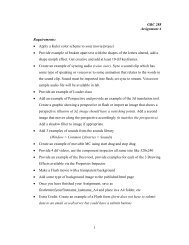Introducing Financial Accounting - CCSN Computer Graphics Program
Introducing Financial Accounting - CCSN Computer Graphics Program
Introducing Financial Accounting - CCSN Computer Graphics Program
You also want an ePaper? Increase the reach of your titles
YUMPU automatically turns print PDFs into web optimized ePapers that Google loves.
wiL27041_ch01_002-047.indd Page 40 10/4/10 7:13:04 PM user-f499 /Volumes/204/MHBR211/wiL27041_disk1of1/0073527041/wiL27041_pagefiles<br />
40 Chapter 1 <strong>Introducing</strong> <strong>Financial</strong> <strong>Accounting</strong><br />
Check (1a) 15.5%; (1b) 15.8%<br />
Problem 1-12A A<br />
Identifying risk and return<br />
A3<br />
Problem 1-13A B<br />
Describing organizational<br />
activities C5<br />
Problem 1-14A B<br />
Describing organizational<br />
activities<br />
C5<br />
PROBLEM SET B<br />
Problem 1-1B<br />
Identifying effects of<br />
transactions on financial<br />
statements A1 P1<br />
Required<br />
1. Compute return on assets for (a) Coca-Cola and (b) PepsiCo.<br />
2. Which company is more successful in its total amount of sales to consumers?<br />
3. Which company is more successful in returning net income from its assets invested?<br />
Analysis Component<br />
4. Write a one-paragraph memorandum explaining which company you would invest your money in and<br />
why. (Limit your explanation to the information provided.)<br />
All business decisions involve aspects of risk and return.<br />
Required<br />
Identify both the risk and the return in each of the following activities:<br />
1. Investing $1,000 in a 4% savings account.<br />
2. Placing a $1,000 bet on your favorite sports team.<br />
3. Investing $10,000 in Yahoo! stock.<br />
4. Taking out a $10,000 college loan to earn an accounting degree.<br />
An organization undertakes various activities in pursuit of business success. Identify an organization’s<br />
three major business activities, and describe each activity.<br />
A start-up company often engages in the following transactions in its first year of operations. Classify<br />
those transactions in one of the three major categories of an organization’s business activities.<br />
F. Financing I. Investing O. Operating<br />
1. Owner investing land in business. 5. Purchasing equipment.<br />
2. Purchasing a building. 6. Selling and distributing products.<br />
3. Purchasing land. 7. Paying for advertising.<br />
4. Borrowing cash from a bank. 8. Paying employee wages.<br />
Income<br />
Balance Sheet Statement Statement of Cash Flows<br />
Total Total Total Net Operating Financing Investing<br />
Transaction Assets Liab. Equity Income Activities Activities Activities<br />
1 Owner invests cash for stock 1 1 1<br />
2 Buys building by signing note payable<br />
3 Pays cash for salaries incurred<br />
4 Provides services for cash<br />
5 Pays cash for rent incurred<br />
6 Incurs utilities costs on credit<br />
7 Buys store equipment for cash<br />
8 Pays cash dividend<br />
9 Provides services on credit<br />
10 Collects cash on receivable from (9)<br />
Identify how each of the following separate transactions affects financial statements. For the balance<br />
sheet, identify how each transaction affects total assets, total liabilities, and total equity. For the income<br />
statement, identify how each transaction affects net income. For the statement of cash flows, identify<br />
how each transaction affects cash flows from operating activities, cash flows from financing activities,<br />
and cash flows from investing activities. For increases, place a “1” in the column or columns. For decreases,<br />
place a “2” in the column or columns. If both an increase and a decrease occur, place “1y2”<br />
in the column or columns. The first transaction is completed as an example.









